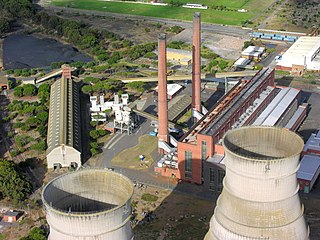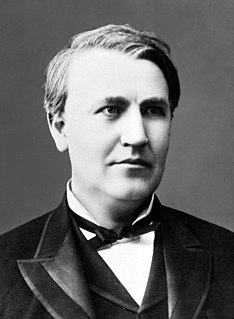
Thomas Alva Edison was an American inventor and businessman. He developed many devices in fields such as electric power generation, mass communication, sound recording, and motion pictures. These inventions, which include the phonograph, the motion picture camera, and early versions of the electric light bulb, have had a widespread impact on the modern industrialized world. He was one of the first inventors to apply the principles of organized science and teamwork to the process of invention, working with many researchers and employees. He established the first industrial research laboratory.

An incandescent light bulb, incandescent lamp or incandescent light globe is an electric light with a wire filament heated until it glows. The filament is enclosed in a glass bulb with a vacuum or inert gas to protect the filament from oxidation. Current is supplied to the filament by terminals or wires embedded in the glass. A bulb socket provides mechanical support and electrical connections.

Sir Joseph Wilson Swan FRS was an English physicist, chemist, and inventor. He is known as an independent early developer of a successful incandescent light bulb, and is the person responsible for developing and supplying the first incandescent lights used to illuminate homes and public buildings, including the Savoy Theatre, London, in 1881.

Appleton is a city in Outagamie, Calumet, and Winnebago counties in the U.S. state of Wisconsin. One of the Fox Cities, it is situated on the Fox River, 30 miles (48 km) southwest of Green Bay and 100 miles (160 km) north of Milwaukee. Appleton is the county seat of Outagamie County. As of the 2020 Census it had a population of 75,644, making it the sixth largest city in Wisconsin. Appleton is a part of the Fox Cities metropolitan area, the third largest in the state behind Milwaukee and Madison.

A power station, also referred to as a power plant and sometimes generating station or generating plant, is an industrial facility for the generation of electric power. Power stations are generally connected to an electrical grid.

The war of the currents was a series of events surrounding the introduction of competing electric power transmission systems in the late 1880s and early 1890s. It grew out of two lighting systems developed in the late 1870s and early 1880s; arc lamp street lighting running on high-voltage alternating current (AC), and large-scale low-voltage direct current (DC) indoor incandescent lighting being marketed by Thomas Edison's company. In 1886, the Edison system was faced with new competition: an alternating current system developed by George Westinghouse's company that used transformers to step down from a high voltage so AC could be used for indoor lighting. Using high voltage allowed an AC system to transmit power over longer distances from more efficient large central generating stations. As the use of AC spread rapidly, the Edison Electric Light Company claimed in early 1888 that high voltages used in an alternating current system were hazardous, and that the design was inferior to, and infringed on the patents behind, their direct current system.

Heinrich Göbel, or Henry Goebel was a German-born American precision mechanic and inventor. In 1848 he emigrated to New York City, where he resided until his death. He received American citizenship in 1865.
Electrification is the process of powering by electricity and, in many contexts, the introduction of such power by changing over from an earlier power source.

The Edison Illuminating Company was established by Thomas Edison on December 17, 1880, to construct electrical generating stations, initially in New York City. The company was the prototype for other local illuminating companies that were established in the United States during the 1880s.

DTE Energy is a Detroit-based diversified energy company involved in the development and management of energy-related businesses and services in the United States and Canada. Its operating units include an electric utility serving 2.2 million customers and a natural gas utility serving 1.3 million customers in Michigan.

Folsom Powerhouse State Historic Park is a historical site preserving an 1895 alternating current (AC) hydroelectric power station—one of the first in the United States.
The Vulcan Street Plant was the first Edison hydroelectric central station. The plant was built on the Fox River in Appleton, Wisconsin, and put into operation on September 30, 1882. According to the American Society of Mechanical Engineers, the Vulcan Street plant is considered to be "the first hydro-electric central station to serve a system of private and commercial customers in North America". It is a National Historic Mechanical Engineering Landmark, an IEEE milestone and a National Historic Civil Engineering Landmark.

Hydroelectric power in the United States is, as of 2019, the second-largest renewable source of energy in both generation and nominal capacity. In 2019, hydroelectric power produced 38% of the total renewable electricity, and 6.6% of the total U.S. electricity.

Holborn Viaduct power station, named the Edison Electric Light Station, was the world's first coal-fired power station generating electricity for public use. It was built at number 57 Holborn Viaduct in central London, by Thomas Edison's Edison Electric Light Company.

The Hammer Historical Collection of Incandescent Electric Lamps was an exhibit of early electric light bulbs and was collected by William Joseph Hammer. The collection of lamp bulbs is the most comprehensive known in the world. It shows the technology development of the filament electric light bulb during Thomas Edison's lifetime. Hammer's collection was displayed for years in five glass cases at the Headquarters of the American Institute of Electrical Engineers in New York City. It is now housed at The Henry Ford Museum in Dearborn, Michigan.

Albon Man was an American lawyer, scientist, and inventor who was associated with the early technology of the incandescent light bulb. He worked with William Edward Sawyer to develop inventions. He was a scientist and came up with ideas for potential inventions that would be useful for commercial products. Sawyer then worked out the mechanics of Man's ideas to make a workable product. Many of these then were patented by them, including the electric light system, which is the cornerstone of modern methods of electrical distribution.
The Electro-Dynamic Light Company of New York was a lighting and electrical distribution company organized in 1878. The company held the patents for the first practical incandescent electric lamp and electrical distribution system of incandescent electric lighting. They also held a patent for an electric meter to measure the amount of electricity used. The inventions were those of Albon Man and William E. Sawyer. They gave the patent rights to the company, which they had formed with a group of businessmen. It was the first company in the world formally established to provided electric lighting and was the first company organized specifically to manufacture and sell incandescent electric light bulbs.

The Electric Light Works Building, also known as Gesa Power House Theatre, is a noteworthy building in Walla Walla, Washington that has aided in the growth and success of the city. It started out as a substation in the early 20th century, supplying Walla Walla with electricity, supporting economic growth, and allowing it to develop into a city of now over 30,000 people. It was one of the first substations that converted hydropower to electricity in Washington state and is a good example of industrial architecture in the 1900s. Today it is as much a symbol of Walla Walla’s history as it is of the ever-changing culture of Walla Walla.

The Sioux Falls Light and Power Hydro Electric Plant, formerly the Northern States Power Building, is a historic building in Falls Park in Sioux Falls, South Dakota. Originally built as a hydroelectric power plant on the Big Sioux River, it now houses the Falls Overlook Cafe. It was listed on the National Register of Historic Places in 1993.


















